Abstract
The etiology of hypertrophic scarring, a pathological end point of wound healing, is unknown. The scars most commonly occur when epithelialization has been delayed during, for example, the healing of deep dermal burn wounds. Hypertrophic scars are conventionally described as a dermal pathology in which the epidermis has only a passive role. In this study, the expression of keratin intermediate filament proteins and filaggrin has been investigated in the epidermis of hypertrophic scars and site-matched controls from the same patients. Hypertrophic scar epidermis was found to express the hyperproliferative keratins K6 and K16 in interfollicular epidermis in association with K17 and precocious expression of filaggrin. K16 mRNA was localized by in situ hybridization using a highly specific cRNA probe. In contrast to the immunohistochemical location of K16 protein, the K16 mRNA was found to be expressed in the basal cell layer of normal skin. In hypertrophic scars the mRNA distribution corroborated the abnormal K16 protein distribution. These results suggest the keratinocytes in hypertrophic scar epidermis have entered an alternative differentiation pathway and are expressing an activated phenotype. Activated keratinocytes are a feature of the early stages of wound healing producing growth factors that influence fibroblasts, endothelial cells, and the inflammatory response. We propose that cellular mechanisms in the pathogenesis of hypertrophic scarring are more complex than isolated dermal phenomena. The persistence of activated keratinocytes in hypertrophic scar epidermis implicates abnormal epidermal-mesenchymal interactions.
Full text
PDF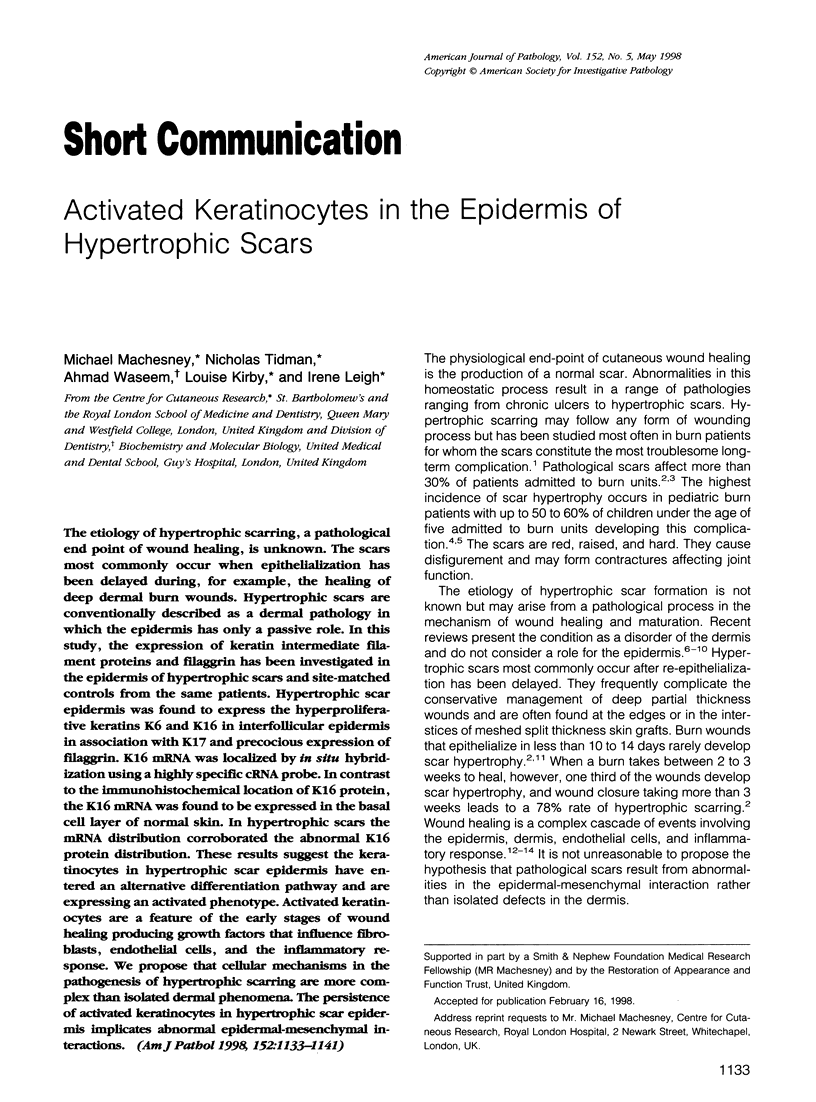
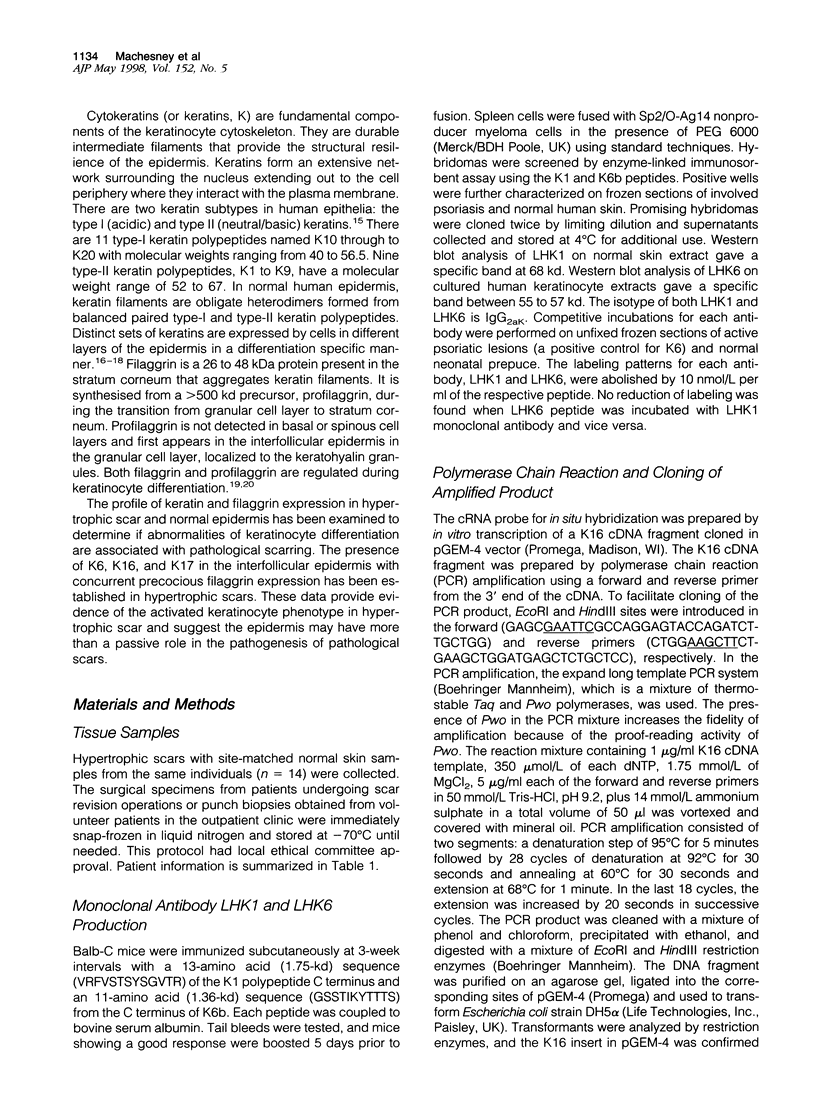
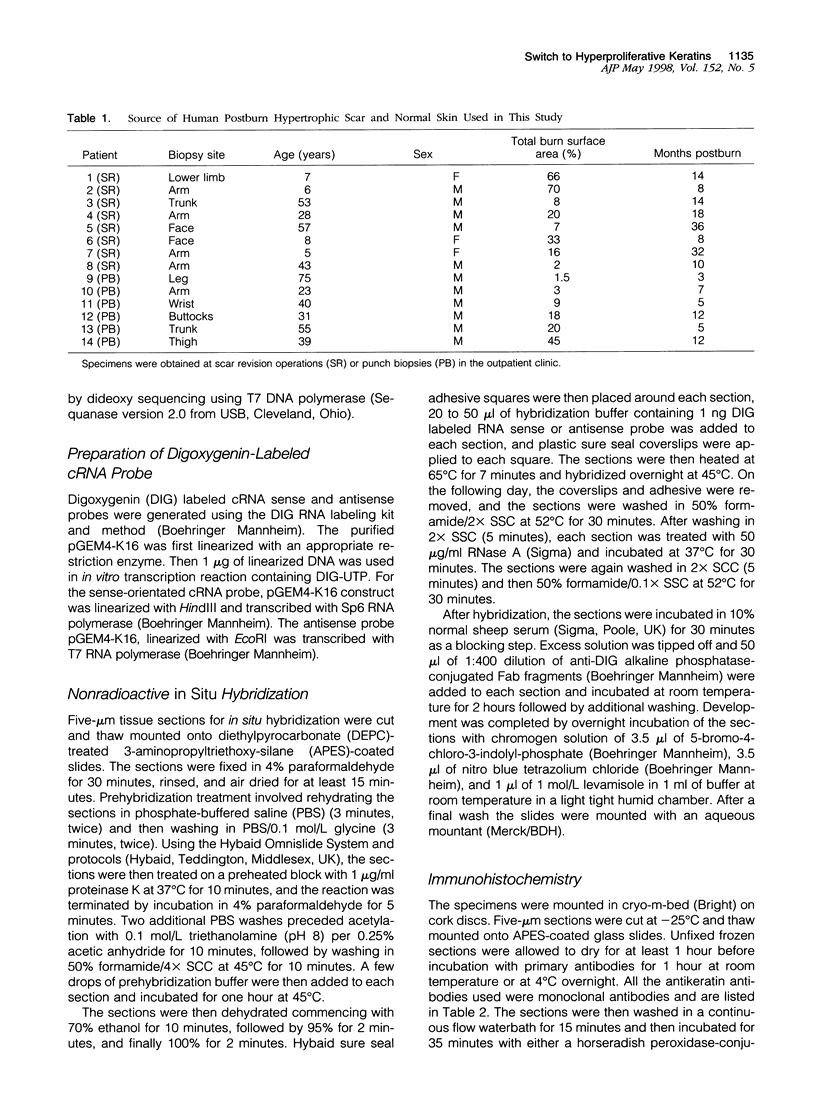

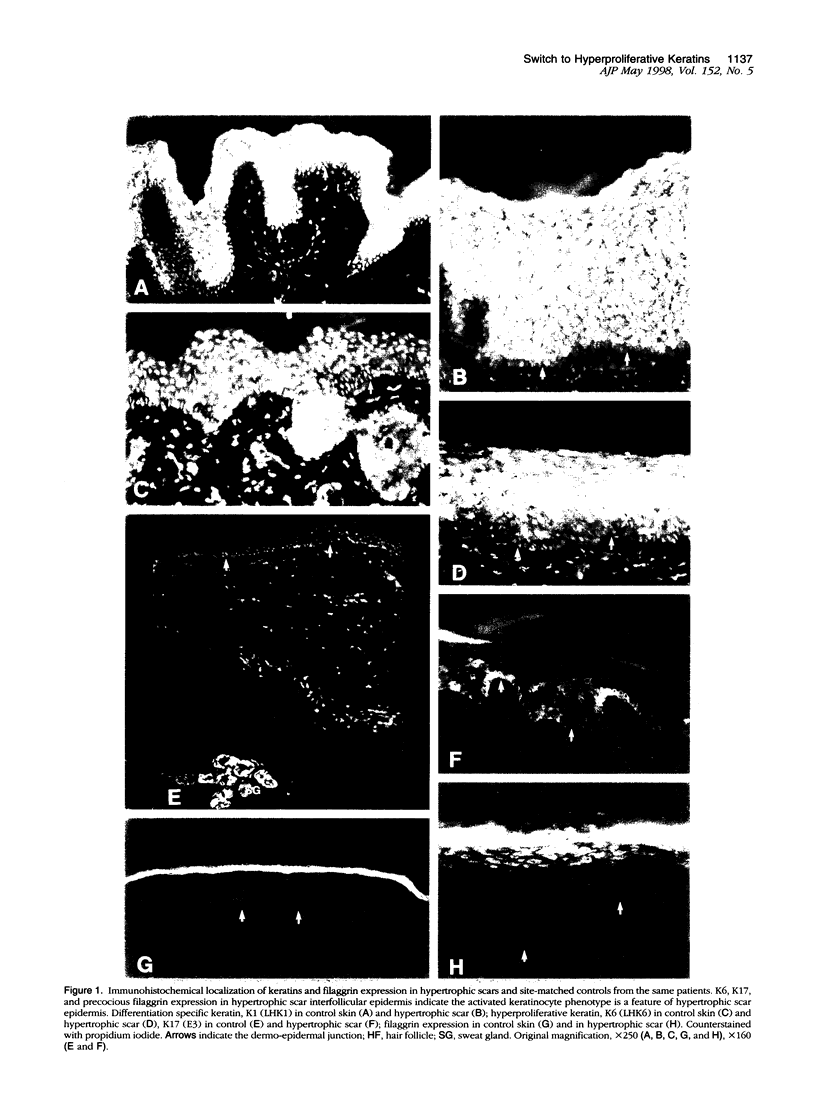
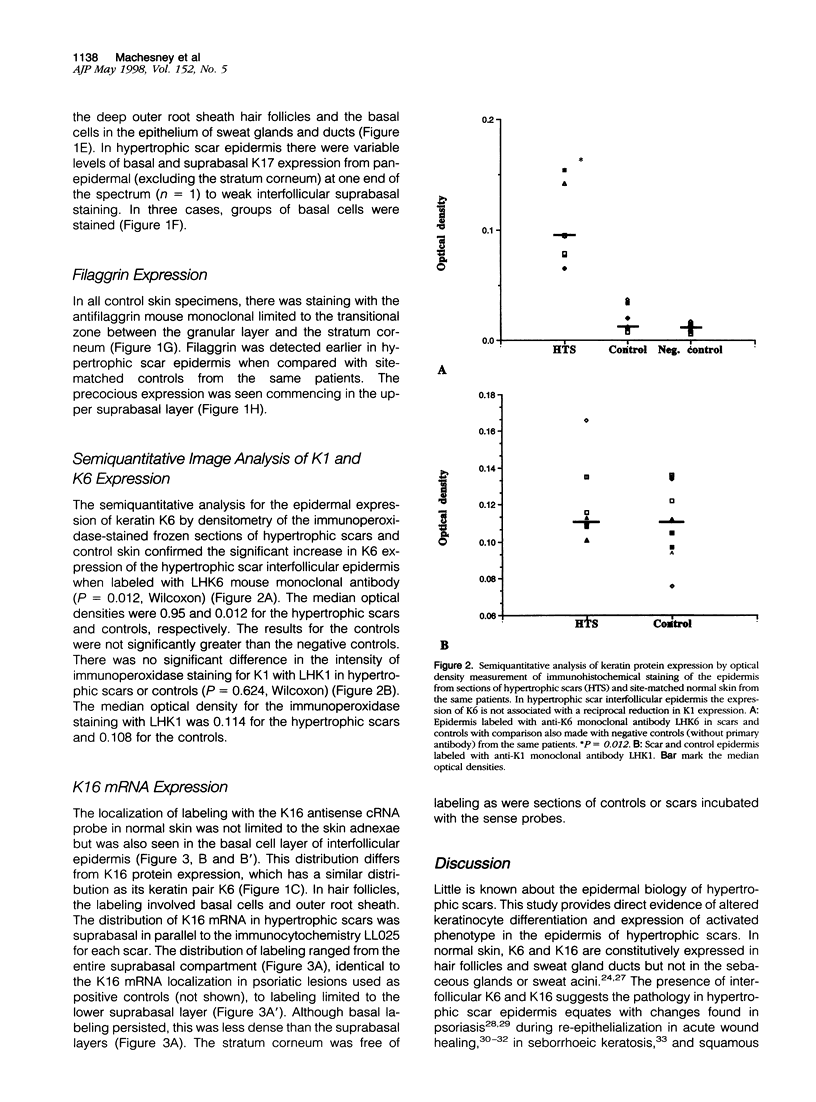

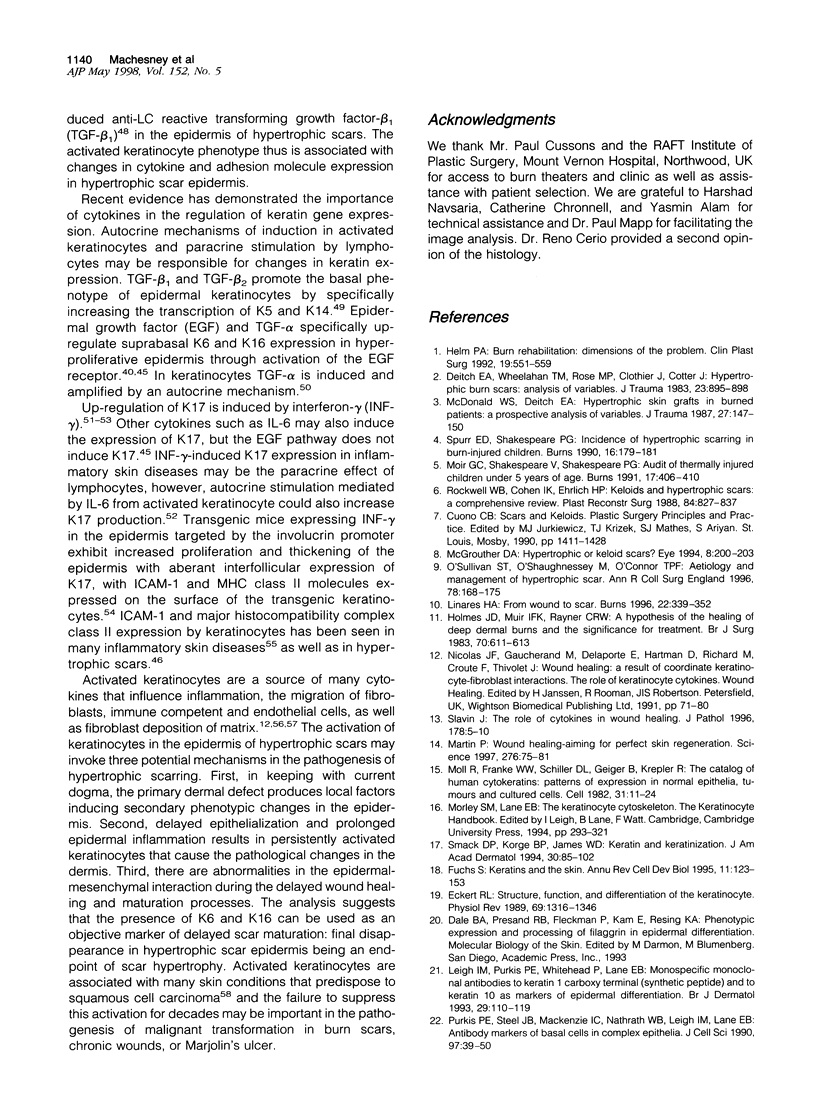
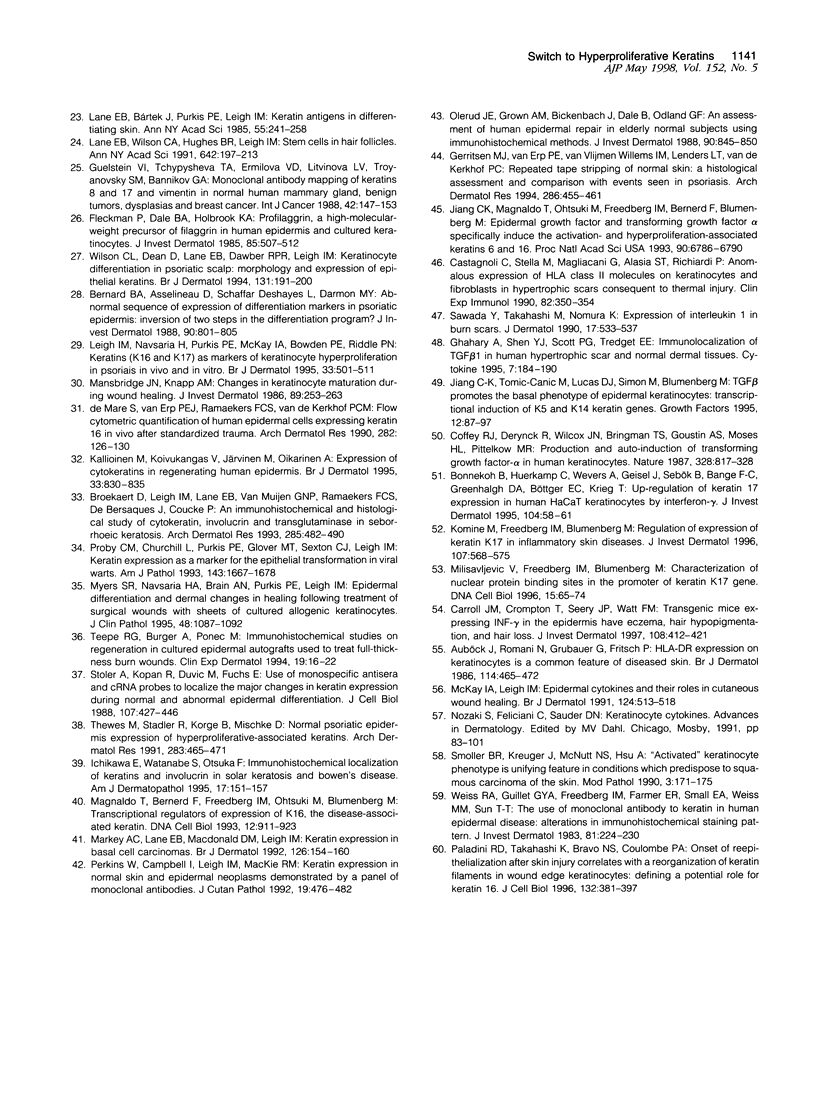
Images in this article
Selected References
These references are in PubMed. This may not be the complete list of references from this article.
- Auböck J., Romani N., Grubauer G., Fritsch P. HLA-DR expression on keratinocytes is a common feature of diseased skin. Br J Dermatol. 1986 Apr;114(4):465–472. doi: 10.1111/j.1365-2133.1986.tb02851.x. [DOI] [PubMed] [Google Scholar]
- Bernard B. A., Asselineau D., Schaffar-Deshayes L., Darmon M. Y. Abnormal sequence of expression of differentiation markers in psoriatic epidermis: inversion of two steps in the differentiation program? J Invest Dermatol. 1988 Jun;90(6):801–805. doi: 10.1111/1523-1747.ep12462014. [DOI] [PubMed] [Google Scholar]
- Bonnekoh B., Huerkamp C., Wevers A., Geisel J., Sebök B., Bange F. C., Greenhalgh D. A., Böttger E. C., Krieg T., Mahrle G. Up-regulation of keratin 17 expression in human HaCaT keratinocytes by interferon-gamma. J Invest Dermatol. 1995 Jan;104(1):58–61. doi: 10.1111/1523-1747.ep12613492. [DOI] [PubMed] [Google Scholar]
- Broekaert D., Leigh I. M., Lane E. B., Van Muijen G. N., Ramaekers F. C., De Bersaques J., Coucke P. An immunohistochemical and histochemical study of cytokeratin, involucrin and transglutaminase in seborrhoeic keratosis. Arch Dermatol Res. 1993;285(8):482–490. doi: 10.1007/BF00376821. [DOI] [PubMed] [Google Scholar]
- Carroll J. M., Crompton T., Seery J. P., Watt F. M. Transgenic mice expressing IFN-gamma in the epidermis have eczema, hair hypopigmentation, and hair loss. J Invest Dermatol. 1997 Apr;108(4):412–422. doi: 10.1111/1523-1747.ep12289702. [DOI] [PubMed] [Google Scholar]
- Castagnoli C., Stella M., Magliacani G., Alasia S. T., Richiardi P. Anomalous expression of HLA class II molecules on keratinocytes and fibroblasts in hypertrophic scars consequent to thermal injury. Clin Exp Immunol. 1990 Nov;82(2):350–354. doi: 10.1111/j.1365-2249.1990.tb05451.x. [DOI] [PMC free article] [PubMed] [Google Scholar]
- Coffey R. J., Jr, Derynck R., Wilcox J. N., Bringman T. S., Goustin A. S., Moses H. L., Pittelkow M. R. Production and auto-induction of transforming growth factor-alpha in human keratinocytes. 1987 Aug 27-Sep 2Nature. 328(6133):817–820. doi: 10.1038/328817a0. [DOI] [PubMed] [Google Scholar]
- Deitch E. A., Wheelahan T. M., Rose M. P., Clothier J., Cotter J. Hypertrophic burn scars: analysis of variables. J Trauma. 1983 Oct;23(10):895–898. [PubMed] [Google Scholar]
- Eckert R. L. Structure, function, and differentiation of the keratinocyte. Physiol Rev. 1989 Oct;69(4):1316–1346. doi: 10.1152/physrev.1989.69.4.1316. [DOI] [PubMed] [Google Scholar]
- Fleckman P., Dale B. A., Holbrook K. A. Profilaggrin, a high-molecular-weight precursor of filaggrin in human epidermis and cultured keratinocytes. J Invest Dermatol. 1985 Dec;85(6):507–512. doi: 10.1111/1523-1747.ep12277306. [DOI] [PubMed] [Google Scholar]
- Fuchs E. Keratins and the skin. Annu Rev Cell Dev Biol. 1995;11:123–153. doi: 10.1146/annurev.cb.11.110195.001011. [DOI] [PubMed] [Google Scholar]
- Gerritsen M. J., van Erp P. E., van Vlijmen-Willems I. M., Lenders L. T., van de Kerkhof P. C. Repeated tape stripping of normal skin: a histological assessment and comparison with events seen in psoriasis. Arch Dermatol Res. 1994;286(8):455–461. doi: 10.1007/BF00371571. [DOI] [PubMed] [Google Scholar]
- Ghahary A., Shen Y. J., Scott P. G., Tredget E. E. Immunolocalization of TGF-beta 1 in human hypertrophic scar and normal dermal tissues. Cytokine. 1995 Feb;7(2):184–190. doi: 10.1006/cyto.1995.1025. [DOI] [PubMed] [Google Scholar]
- Guelstein V. I., Tchypysheva T. A., Ermilova V. D., Litvinova L. V., Troyanovsky S. M., Bannikov G. A. Monoclonal antibody mapping of keratins 8 and 17 and of vimentin in normal human mammary gland, benign tumors, dysplasias and breast cancer. Int J Cancer. 1988 Aug 15;42(2):147–153. doi: 10.1002/ijc.2910420202. [DOI] [PubMed] [Google Scholar]
- Helm P. A. Burn rehabilitation: dimensions of the problem. Clin Plast Surg. 1992 Jul;19(3):551–559. [PubMed] [Google Scholar]
- Holmes J. D., Muir I. F., Rayner C. R. A hypothesis of the healing of deep dermal burns and the significance for treatment. Br J Surg. 1983 Oct;70(10):611–613. doi: 10.1002/bjs.1800701014. [DOI] [PubMed] [Google Scholar]
- Ichikawa E., Watanabe S., Otsuka F. Immunohistochemical localization of keratins and involucrin in solar keratosis and Bowen's disease. Am J Dermatopathol. 1995 Apr;17(2):151–157. doi: 10.1097/00000372-199504000-00007. [DOI] [PubMed] [Google Scholar]
- Jiang C. K., Magnaldo T., Ohtsuki M., Freedberg I. M., Bernerd F., Blumenberg M. Epidermal growth factor and transforming growth factor alpha specifically induce the activation- and hyperproliferation-associated keratins 6 and 16. Proc Natl Acad Sci U S A. 1993 Jul 15;90(14):6786–6790. doi: 10.1073/pnas.90.14.6786. [DOI] [PMC free article] [PubMed] [Google Scholar]
- Jiang C. K., Tomić-Canić M., Lucas D. J., Simon M., Blumenberg M. TGF beta promotes the basal phenotype of epidermal keratinocytes: transcriptional induction of K#5 and K#14 keratin genes. Growth Factors. 1995;12(2):87–97. doi: 10.3109/08977199509028955. [DOI] [PubMed] [Google Scholar]
- Kallioinen M., Koivukangas V., Järvinen M., Oikarinen A. Expression of cytokeratins in regenerating human epidermis. Br J Dermatol. 1995 Dec;133(6):830–835. doi: 10.1111/j.1365-2133.1995.tb06912.x. [DOI] [PubMed] [Google Scholar]
- Komine M., Freedberg I. M., Blumenberg M. Regulation of epidermal expression of keratin K17 in inflammatory skin diseases. J Invest Dermatol. 1996 Oct;107(4):569–575. doi: 10.1111/1523-1747.ep12582820. [DOI] [PubMed] [Google Scholar]
- Lane E. B., Bártek J., Purkis P. E., Leigh I. M. Keratin antigens in differentiating skin. Ann N Y Acad Sci. 1985;455:241–258. doi: 10.1111/j.1749-6632.1985.tb50415.x. [DOI] [PubMed] [Google Scholar]
- Lane E. B., Wilson C. A., Hughes B. R., Leigh I. M. Stem cells in hair follicles. Cytoskeletal studies. Ann N Y Acad Sci. 1991 Dec 26;642:197–213. doi: 10.1111/j.1749-6632.1991.tb24388.x. [DOI] [PubMed] [Google Scholar]
- Leigh I. M., Navsaria H., Purkis P. E., McKay I. A., Bowden P. E., Riddle P. N. Keratins (K16 and K17) as markers of keratinocyte hyperproliferation in psoriasis in vivo and in vitro. Br J Dermatol. 1995 Oct;133(4):501–511. doi: 10.1111/j.1365-2133.1995.tb02696.x. [DOI] [PubMed] [Google Scholar]
- Leigh I. M., Purkis P. E., Whitehead P., Lane E. B. Monospecific monoclonal antibodies to keratin 1 carboxy terminal (synthetic peptide) and to keratin 10 as markers of epidermal differentiation. Br J Dermatol. 1993 Aug;129(2):110–119. doi: 10.1111/j.1365-2133.1993.tb03511.x. [DOI] [PubMed] [Google Scholar]
- Linares H. A. From wound to scar. Burns. 1996 Aug;22(5):339–352. doi: 10.1016/0305-4179(95)00164-6. [DOI] [PubMed] [Google Scholar]
- Magnaldo T., Bernerd F., Freedberg I. M., Ohtsuki M., Blumenberg M. Transcriptional regulators of expression of K#16, the disease-associated keratin. DNA Cell Biol. 1993 Dec;12(10):911–923. doi: 10.1089/dna.1993.12.911. [DOI] [PubMed] [Google Scholar]
- Mansbridge J. N., Knapp A. M. Changes in keratinocyte maturation during wound healing. J Invest Dermatol. 1987 Sep;89(3):253–263. doi: 10.1111/1523-1747.ep12471216. [DOI] [PubMed] [Google Scholar]
- Markey A. C., Lane E. B., Macdonald D. M., Leigh I. M. Keratin expression in basal cell carcinomas. Br J Dermatol. 1992 Feb;126(2):154–160. doi: 10.1111/j.1365-2133.1992.tb07813.x. [DOI] [PubMed] [Google Scholar]
- Martin P. Wound healing--aiming for perfect skin regeneration. Science. 1997 Apr 4;276(5309):75–81. doi: 10.1126/science.276.5309.75. [DOI] [PubMed] [Google Scholar]
- McDonald W. S., Deitch E. A. Hypertrophic skin grafts in burned patients: a prospective analysis of variables. J Trauma. 1987 Feb;27(2):147–150. doi: 10.1097/00005373-198702000-00008. [DOI] [PubMed] [Google Scholar]
- McGrouther D. A. Hypertrophic or keloid scars? Eye (Lond) 1994;8(Pt 2):200–203. doi: 10.1038/eye.1994.46. [DOI] [PubMed] [Google Scholar]
- McKay I. A., Leigh I. M. Epidermal cytokines and their roles in cutaneous wound healing. Br J Dermatol. 1991 Jun;124(6):513–518. doi: 10.1111/j.1365-2133.1991.tb04942.x. [DOI] [PubMed] [Google Scholar]
- Milisavljevic V., Freedberg I. M., Blumenberg M. Characterization of nuclear protein binding sites in the promoter of keratin K17 gene. DNA Cell Biol. 1996 Jan;15(1):65–74. doi: 10.1089/dna.1996.15.65. [DOI] [PubMed] [Google Scholar]
- Moir G. C., Shakespeare V., Shakespeare P. G. Audit of thermally injured children under 5 years of age. Burns. 1991 Oct;17(5):406–410. doi: 10.1016/s0305-4179(05)80076-2. [DOI] [PubMed] [Google Scholar]
- Moll R., Franke W. W., Schiller D. L., Geiger B., Krepler R. The catalog of human cytokeratins: patterns of expression in normal epithelia, tumors and cultured cells. Cell. 1982 Nov;31(1):11–24. doi: 10.1016/0092-8674(82)90400-7. [DOI] [PubMed] [Google Scholar]
- Myers S. R., Navsaria H. A., Brain A. N., Purkis P. E., Leigh I. M. Epidermal differentiation and dermal changes in healing following treatment of surgical wounds with sheets of cultured allogeneic keratinocytes. J Clin Pathol. 1995 Dec;48(12):1087–1092. doi: 10.1136/jcp.48.12.1087. [DOI] [PMC free article] [PubMed] [Google Scholar]
- O'Sullivan S. T., O'Shaughnessy M., O'Connor T. P. Aetiology and management of hypertrophic scars and keloids. Ann R Coll Surg Engl. 1996 May;78(3 ):168–175. [PMC free article] [PubMed] [Google Scholar]
- Olerud J. E., Gown A. M., Bickenbach J., Dale B., Odland G. F. An assessment of human epidermal repair in elderly normal subjects using immunohistochemical methods. J Invest Dermatol. 1988 Jun;90(6):845–850. doi: 10.1111/1523-1747.ep12462083. [DOI] [PubMed] [Google Scholar]
- Paladini R. D., Takahashi K., Bravo N. S., Coulombe P. A. Onset of re-epithelialization after skin injury correlates with a reorganization of keratin filaments in wound edge keratinocytes: defining a potential role for keratin 16. J Cell Biol. 1996 Feb;132(3):381–397. doi: 10.1083/jcb.132.3.381. [DOI] [PMC free article] [PubMed] [Google Scholar]
- Perkins W., Campbell I., Leigh I. M., MacKie R. M. Keratin expression in normal skin and epidermal neoplasms demonstrated by a panel of monoclonal antibodies. J Cutan Pathol. 1992 Dec;19(6):476–482. doi: 10.1111/j.1600-0560.1992.tb01600.x. [DOI] [PubMed] [Google Scholar]
- Proby C. M., Churchill L., Purkis P. E., Glover M. T., Sexton C. J., Leigh I. M. Keratin 17 expression as a marker for epithelial transformation in viral warts. Am J Pathol. 1993 Dec;143(6):1667–1678. [PMC free article] [PubMed] [Google Scholar]
- Purkis P. E., Steel J. B., Mackenzie I. C., Nathrath W. B., Leigh I. M., Lane E. B. Antibody markers of basal cells in complex epithelia. J Cell Sci. 1990 Sep;97(Pt 1):39–50. doi: 10.1242/jcs.97.1.39. [DOI] [PubMed] [Google Scholar]
- Rockwell W. B., Cohen I. K., Ehrlich H. P. Keloids and hypertrophic scars: a comprehensive review. Plast Reconstr Surg. 1989 Nov;84(5):827–837. doi: 10.1097/00006534-198911000-00021. [DOI] [PubMed] [Google Scholar]
- Sawada Y., Takahashi M., Nomura K. Expression of interleukin 1 in burn scars. J Dermatol. 1990 Sep;17(9):533–537. doi: 10.1111/j.1346-8138.1990.tb01690.x. [DOI] [PubMed] [Google Scholar]
- Slavin J. The role of cytokines in wound healing. J Pathol. 1996 Jan;178(1):5–10. doi: 10.1002/(SICI)1096-9896(199601)178:1<5::AID-PATH443>3.0.CO;2-W. [DOI] [PubMed] [Google Scholar]
- Smack D. P., Korge B. P., James W. D. Keratin and keratinization. J Am Acad Dermatol. 1994 Jan;30(1):85–102. doi: 10.1016/s0190-9622(94)70012-5. [DOI] [PubMed] [Google Scholar]
- Smoller B. R., Krueger J., McNutt N. S., Hsu A. "Activated" keratinocyte phenotype is unifying feature in conditions which predispose to squamous cell carcinoma of the skin. Mod Pathol. 1990 Mar;3(2):171–175. [PubMed] [Google Scholar]
- Spurr E. D., Shakespeare P. G. Incidence of hypertrophic scarring in burn-injured children. Burns. 1990 Jun;16(3):179–181. doi: 10.1016/0305-4179(90)90034-t. [DOI] [PubMed] [Google Scholar]
- Stoler A., Kopan R., Duvic M., Fuchs E. Use of monospecific antisera and cRNA probes to localize the major changes in keratin expression during normal and abnormal epidermal differentiation. J Cell Biol. 1988 Aug;107(2):427–446. doi: 10.1083/jcb.107.2.427. [DOI] [PMC free article] [PubMed] [Google Scholar]
- Teepe R. G., Burger A., Ponec M. Immunohistochemical studies on regeneration in cultured epidermal autografts used to treat full-thickness burn wounds. Clin Exp Dermatol. 1994 Jan;19(1):16–22. doi: 10.1111/j.1365-2230.1994.tb01108.x. [DOI] [PubMed] [Google Scholar]
- Thewes M., Stadler R., Korge B., Mischke D. Normal psoriatic epidermis expression of hyperproliferation-associated keratins. Arch Dermatol Res. 1991;283(7):465–471. doi: 10.1007/BF00371784. [DOI] [PubMed] [Google Scholar]
- Weiss R. A., Guillet G. Y., Freedberg I. M., Farmer E. R., Small E. A., Weiss M. M., Sun T. T. The use of monoclonal antibody to keratin in human epidermal disease: alterations in immunohistochemical staining pattern. J Invest Dermatol. 1983 Sep;81(3):224–230. doi: 10.1111/1523-1747.ep12518198. [DOI] [PubMed] [Google Scholar]
- Wilson C. L., Dean D., Lane E. B., Dawber R. P., Leigh I. M. Keratinocyte differentiation in psoriatic scalp: morphology and expression of epithelial keratins. Br J Dermatol. 1994 Aug;131(2):191–200. doi: 10.1111/j.1365-2133.1994.tb08490.x. [DOI] [PubMed] [Google Scholar]
- de Mare S., van Erp P. E., Ramaekers F. C., van de Kerkhof P. C. Flow cytometric quantification of human epidermal cells expressing keratin 16 in vivo after standardized trauma. Arch Dermatol Res. 1990;282(2):126–130. doi: 10.1007/BF00493471. [DOI] [PubMed] [Google Scholar]




